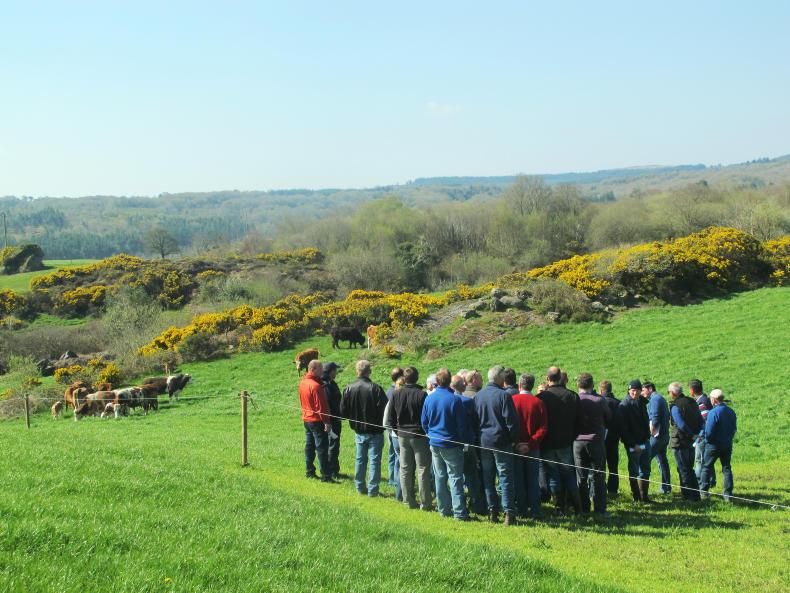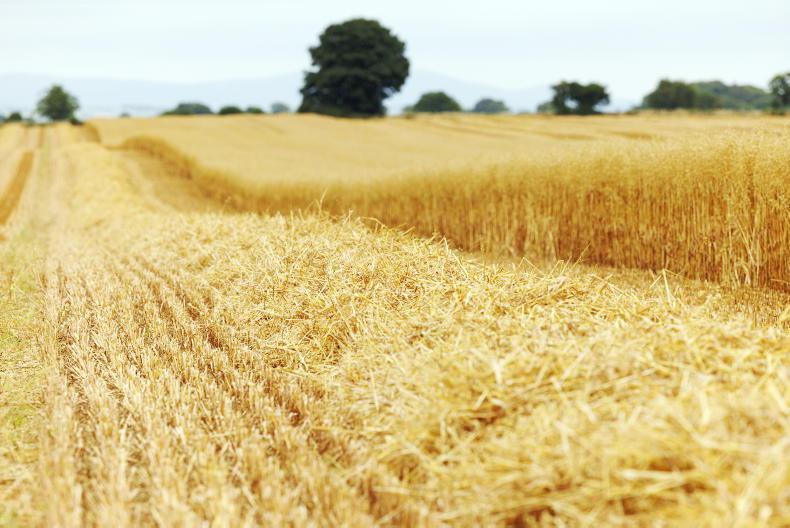A Grass10 farm walk recently took place on the farm of Ger Dineen in Kilnamartrya, Macroom, Co Cork. Ger is the national beef winner of the 2017 Grassland farmer of the year award.
Over 300 people from around the country attended the event. The Grassland farmer of the year competition promotes the effective utilisation of the national grassland resource on beef, dairy and sheep farms. Ger Dineen is an excellent example of a farmer who is growing more grass and grazing more grass, which is improving the profitability of his business.
The Teagasc Grass10 campaign is focused on increasing the quantity of grass utilised on livestock farms with the objective of achieving 10t grass dry matter per hectare per annum utilised, with 10 grazings per paddock per year. Its focus is on the sustainable production of milk and meat from grass.

Grass performance
In 2011, Ger was growing 7t of grass per hectare. By 2016, he was growing an average of 14t/ha. He describes it as being like having an extra farm next door to him. In the same time, his stocking rate grew from 1.71 to 2.47LU/ha.
An average of eight grazings per paddock in 2017 gave an increase of two grazings per year from his 2015 figures. This also takes into account paddocks cut for silage.
Between 2015 and 2017, Ger completed an average of 31 grass measures in the year, which he recorded on PastureBase Ireland. This enabled him to see what his best- and worst-performing paddocks were growing and take remedial action. The grazing season length in 2017 was 275 days. This ran from 15 February to 15 November. He is spreading 30 units of nitrogen/acre/month.
For ease of management, all his animals are run in the one mob. This consists of cows and calves, as well as all replacement heifers. This allows him graze out a paddock in two days. All the wires in the paddocks are raised so the calves graze ahead of the cows.
“I have no creep feeder. My heifer calves average 1.3kg/day weight gain and the bulls 1.5kg/day. Every 0.1kg weight gain is worth €100 to me. When you are finishing bulls you should try and get them as heavy as you can before weaning,” he says.
Reseeding
Ger reseeds 10% to 15% of the farm every year, usually at the start of August. This will vary on the amount of grass he has at the time. The worst-performing paddocks are picked out from PastureBase and reseeded. See Table 2.

Breeding
All heifers and cows are bred to high-index maternal sires. In 2018, Ger used Simmental, Salers, Angus, Limousin and Shorthorn. He doesn’t use terminal bulls and explained why.
“Every cow is bred to have a replacement heifer. The bull calves are finished then so I would have about 30 heifers. It’s fierce important to have a huge amount of heifers coming in because you can cull bad cows. With grass, the poor paddocks are taken out and reseeded and it’s the same with the cows.”
Those present at the walk were able to see the last eight bulls Ger had for finishing this spring. The bulls he slaughtered to date in 2018 had an average replacement index of €162. Average carcase weight was 463kg at 15.5 months and their average grade was U=3=. Their average price was €2,079.

Read more
All beef articles
Beef farmers in the grassland competition
New BETTER farmers tour top-performing phase two farms
A Grass10 farm walk recently took place on the farm of Ger Dineen in Kilnamartrya, Macroom, Co Cork. Ger is the national beef winner of the 2017 Grassland farmer of the year award.
Over 300 people from around the country attended the event. The Grassland farmer of the year competition promotes the effective utilisation of the national grassland resource on beef, dairy and sheep farms. Ger Dineen is an excellent example of a farmer who is growing more grass and grazing more grass, which is improving the profitability of his business.
The Teagasc Grass10 campaign is focused on increasing the quantity of grass utilised on livestock farms with the objective of achieving 10t grass dry matter per hectare per annum utilised, with 10 grazings per paddock per year. Its focus is on the sustainable production of milk and meat from grass.

Grass performance
In 2011, Ger was growing 7t of grass per hectare. By 2016, he was growing an average of 14t/ha. He describes it as being like having an extra farm next door to him. In the same time, his stocking rate grew from 1.71 to 2.47LU/ha.
An average of eight grazings per paddock in 2017 gave an increase of two grazings per year from his 2015 figures. This also takes into account paddocks cut for silage.
Between 2015 and 2017, Ger completed an average of 31 grass measures in the year, which he recorded on PastureBase Ireland. This enabled him to see what his best- and worst-performing paddocks were growing and take remedial action. The grazing season length in 2017 was 275 days. This ran from 15 February to 15 November. He is spreading 30 units of nitrogen/acre/month.
For ease of management, all his animals are run in the one mob. This consists of cows and calves, as well as all replacement heifers. This allows him graze out a paddock in two days. All the wires in the paddocks are raised so the calves graze ahead of the cows.
“I have no creep feeder. My heifer calves average 1.3kg/day weight gain and the bulls 1.5kg/day. Every 0.1kg weight gain is worth €100 to me. When you are finishing bulls you should try and get them as heavy as you can before weaning,” he says.
Reseeding
Ger reseeds 10% to 15% of the farm every year, usually at the start of August. This will vary on the amount of grass he has at the time. The worst-performing paddocks are picked out from PastureBase and reseeded. See Table 2.

Breeding
All heifers and cows are bred to high-index maternal sires. In 2018, Ger used Simmental, Salers, Angus, Limousin and Shorthorn. He doesn’t use terminal bulls and explained why.
“Every cow is bred to have a replacement heifer. The bull calves are finished then so I would have about 30 heifers. It’s fierce important to have a huge amount of heifers coming in because you can cull bad cows. With grass, the poor paddocks are taken out and reseeded and it’s the same with the cows.”
Those present at the walk were able to see the last eight bulls Ger had for finishing this spring. The bulls he slaughtered to date in 2018 had an average replacement index of €162. Average carcase weight was 463kg at 15.5 months and their average grade was U=3=. Their average price was €2,079.

Read more
All beef articles
Beef farmers in the grassland competition
New BETTER farmers tour top-performing phase two farms












SHARING OPTIONS